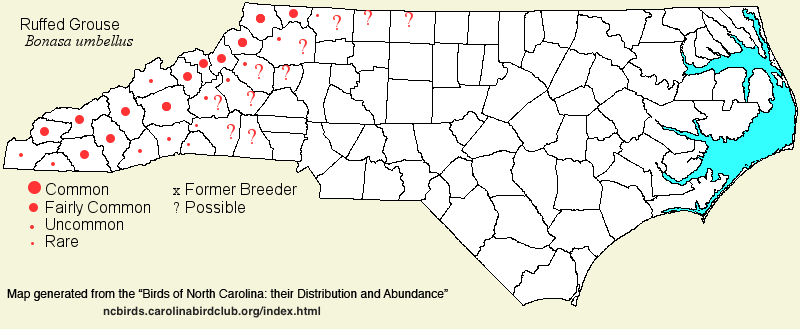 |  |
|
Ruffed Grouse - Bonasa umbellus PHASIANIDAE Members: | Search Common: Search Scientific: |
|
|
|||||||
| General Comments | The state's only grouse species is a widespread, though secretive and often hard-to-find bird of the mountains and higher foothills. Extensive second-home developments have sprung up in much of the non-protected portions of its range; this and a few other factors, perhaps including an increase in mammalian predators and a decline in early succession openings within forests, suggest that populations are dwindling, and rather alarmingly in the 2020s. Fortunately, nearly 1.5 million acres of its habitat are protected in Pisgah and Nantahala national forests, Great Smoky Mountains NP, the Blue Ridge Parkway, and various state and other conservation lands. Its favored habitats for breeding are mid- to high elevation hardwood or mixed forests, typically with small openings; cove forests and northern hardwood forests are favored. In fall and winter, such forests become mostly devoid of cover, and the birds retreat to forests with rhododendron/mountain laurel understory, clearcut thickets, or other brushy areas, but close to forest cover. | ||||||
| Breeding Status | Breeder | ||||||
| NC BRC List | Definitive | ||||||
| State Status | |||||||
| U.S. Status | |||||||
| State Rank | S4 | ||||||
| Global Rank | G5 | ||||||
| Coastal Plain | No records. | ||||||
| Piedmont | Scarce permanent resident; non-migratory. Very rare to rare and poorly known, in foothill ranges; present in the South Mountains and the Brushy Mountains. There are a few records eastward to Guilford and Caswell, but the species is not known to be resident there. The most recent such report well away from the mountains was a drumming bird in eastern Stokes on 15 May 2025. Peak counts: ? | ||||||
| Mountains | Permanent resident; non-migratory. Strongly declining, formerly fairly common, but now uncommon in most areas. Occurring at nearly all elevations, but preferring areas between about 2,500 and 5,500 feet elevation. Most easily detected (by sound only) in early spring (Mar to early May) when males are drumming, and again in late summer (Jul and Aug) when females are with chicks, often along trails, dirt roads, and shoulders of forested roads. Peak counts: 15, Balsam CBC, 4 Jan 2003. | ||||||
| Finding Tips |
This can be a frustrating bird to find, even though hundreds to possibly a few thousands of grouse occur in each mountain county. The males drum mainly from late Mar to early May, and to some extent in fall. They are silent during the time when most people are birding in the mountains in May and Jun. They are easier to find in Jul and Aug, when the female (?) and the young often feed along margins of roads. Your best chance for SEEING them is to drive slowly on lightly-travelled roads, especially paved roads, through forests. Driving in early morning before traffic becomes heavy is important, especially along the Blue Ridge Parkway. You might also see them along some dirt roads, particularly U.S. Forest Service roads, but again where and when few other vehicles have passed by in recent minutes. Walking wooded trails is less effective, but you can occasionally startle birds in the woods near the trails. However, these birds rarely can be re-found once they are flushed. ** | ||||||
| Attribution | LeGrand[2025-07-23], LeGrand[2025-04-04], LeGrand[2023-03-02] | ||||||
| NC Map Map depicts all counties with a report (transient or resident) for the species. | Click on county for list of all known species. |
| NC Breeding Season Map Map depicts assumed breeding season abundance for the species. |  |